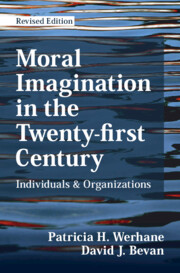Book contents
- Moral Imagination in the Twenty-first Century
- Moral Imagination in the Twenty-first Century
- Copyright page
- Contents
- Acknowledgments
- 1 Introduction
- 2 Why Do Good People and Great Organizations Do Bad Things?
- 3 Social Constructivism and the Very Idea of a Conceptual Scheme
- 4 The Rashomon Effect
- 5 Moral Imagination
- 6 Moral Reasoning and Moral Imagination
- 7 Systems Thinking, Process Philosophy, and Moral Imagination
- 8 Next Stages
- 9 Moral Imagination in Technological Development
- References
- Index
9 - Moral Imagination in Technological Development
Published online by Cambridge University Press: 30 October 2025
- Moral Imagination in the Twenty-first Century
- Moral Imagination in the Twenty-first Century
- Copyright page
- Contents
- Acknowledgments
- 1 Introduction
- 2 Why Do Good People and Great Organizations Do Bad Things?
- 3 Social Constructivism and the Very Idea of a Conceptual Scheme
- 4 The Rashomon Effect
- 5 Moral Imagination
- 6 Moral Reasoning and Moral Imagination
- 7 Systems Thinking, Process Philosophy, and Moral Imagination
- 8 Next Stages
- 9 Moral Imagination in Technological Development
- References
- Index
Summary
The day-to-day decisions of technologists have a profound role in shaping people’s interactions with the world. As many philosophers of technology have argued, every technological decision can also be seen as an ethical one. The shape and affordances of technologies determine what people can do with them, and how social systems evolve around them. Most technologists generally have positive intentions and strive to do good, but the ethical outcomes of their work can be particularly complex and unpredictable. Adverse consequences can often arise not from malice but from failure to appreciate the full implications of technological advancements amidst the delicate interplay between technology, human behavior, and social dynamics.
In our roles at Google, we have heard a strong desire to reshape technology development processes to explicitly incorporate ethical and social considerations.
Keywords
Information
- Type
- Chapter
- Information
- Moral Imagination in the Twenty-first CenturyIndividuals and Organizations, pp. 173 - 195Publisher: Cambridge University PressPrint publication year: 2025
Accessibility standard: WCAG 2.1 AA
Why this information is here
This section outlines the accessibility features of this content - including support for screen readers, full keyboard navigation and high-contrast display options. This may not be relevant for you.Accessibility Information
Content Navigation
Allows you to navigate directly to chapters, sections, or non‐text items through a linked table of contents, reducing the need for extensive scrolling.
Provides an interactive index, letting you go straight to where a term or subject appears in the text without manual searching.
Reading Order & Textual Equivalents
You will encounter all content (including footnotes, captions, etc.) in a clear, sequential flow, making it easier to follow with assistive tools like screen readers.
You get concise descriptions (for images, charts, or media clips), ensuring you do not miss crucial information when visual or audio elements are not accessible.
You get more than just short alt text: you have comprehensive text equivalents, transcripts, captions, or audio descriptions for substantial non‐text content, which is especially helpful for complex visuals or multimedia.
Visual Accessibility
You will still understand key ideas or prompts without relying solely on colour, which is especially helpful if you have colour vision deficiencies.
Structural and Technical Features
You gain clarity from ARIA (Accessible Rich Internet Applications) roles and attributes, as they help assistive technologies interpret how each part of the content functions.
